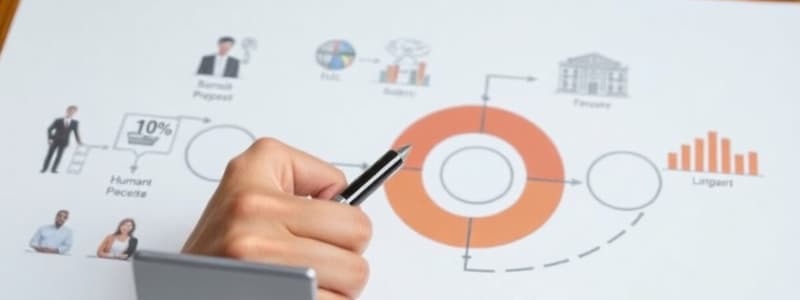Podcast
Questions and Answers
What is included in the job specification regarding mental qualities?
What is included in the job specification regarding mental qualities?
- Physical stamina and endurance
- Intelligence and decision-making ability (correct)
- Communication skills and technical knowledge
- Appearance and personal grooming
What is the first step in the process of Human Resource Planning (HRP)?
What is the first step in the process of Human Resource Planning (HRP)?
- Action Planning
- Anticipate Change in HRI
- Determine the Human Resource Inventory (HRI)
- Determine the total Human Resource Planning Requirement (HRPR) (correct)
Which method of forecasting human resources is considered subjective?
Which method of forecasting human resources is considered subjective?
- Judgment and experience (correct)
- Zero base forecasting
- Statistical modeling
- Trend analysis
In the context of machinery and equipment, what aspect is primarily considered in job duties and responsibilities?
In the context of machinery and equipment, what aspect is primarily considered in job duties and responsibilities?
Which of the following is NOT a part of job specification's personality requirements?
Which of the following is NOT a part of job specification's personality requirements?
What is the first step in developing Job Analysis?
What is the first step in developing Job Analysis?
Which method of Job Analysis is known for being accurate but expensive and time-consuming?
Which method of Job Analysis is known for being accurate but expensive and time-consuming?
What is included in a Job Description?
What is included in a Job Description?
What does Job Specification refer to in the context of Job Analysis?
What does Job Specification refer to in the context of Job Analysis?
Which of the following questions is NOT addressed by the purpose of Job Analysis?
Which of the following questions is NOT addressed by the purpose of Job Analysis?
Flashcards are hidden until you start studying
Study Notes
The Employment Process
- The employment process encompasses acquiring the right number and type of individuals to achieve an organization's goals.
- It includes key tasks like conducting job analysis, planning human resources, recruiting candidates, selecting the best fit, inducting new hires, and placing them into the organization.
Job Analysis
- A systematic process of studying and gathering information about job requirements and the qualifications needed in those who fill the role.
- Job analysis aims to define the tasks, tools, qualifications, and outputs required for the job.
- Common methods for job analysis include:
- Observation (slow and less accurate)
- Interviews (accurate but costly and time-consuming)
- Questionnaires (rapid and cost-effective)
- Employee Logs (suitable for highly specialized work)
Steps in Job Analysis
- Understanding the intended use of the gathered information.
- Gathering background information including organization structure, processes, and objectives.
- Benchmarking positions against similar roles in the industry.
- Collecting detailed job analysis information about behaviors, tasks, required equipment and tools, performance standards, and human resource requirements.
- Reviewing collected data for accuracy with workers, supervisors, and other relevant stakeholders.
- Developing a comprehensive job analysis document.
Purpose of Job Analysis
- To provide answers to six key questions about the job:
- What: What specific tasks or functions are performed?
- Why: What is the reason or purpose behind these tasks?
- What Aids: Which tools, machines, and equipment are used?
- What Qualifications: What skills, abilities, experiences, and knowledge are required?
- What is Accomplished: What are the expected outputs of the job?
- How: What are the specific procedures, methods, techniques, and processes involved?
Components of Job Analysis
- Job Description: A written profile detailing the specific tasks and responsibilities of the job. It's essentially a picture of what the job entails.
- Includes job identity (title, location, grade), purpose of the job, duties and responsibilities, working conditions, equipment used, and other relevant factors.
- Job Specification: A written statement outlining the minimum acceptable human qualities required for the job. These quality requirements are essential for the individual to effectively perform the role.
- Includes factors such as:
- Physical Qualities: Appearance, age, eyesight, hearing, etc.
- Mental Qualities: Intelligence, thinking ability, decision-making skills, etc.
- Skills and Talents: Communication, technical skills, conceptual skills, human relations skills, and computer skills.
- Qualifications: Knowledge acquired through education, training, and experience.
- Personality Requirements: Emotional stability, patience, and other personality traits relevant to the job.
- Includes factors such as:
Human Resource Planning (HRP)
- The process of analyzing and identifying human resource needs and availability to align with organizational objectives.
- HRP assists in detecting short-term and long-term human resource requirements.
Process of HRP
- This process involves five key steps:
- Step 1: Determining Total Human Resource Planning Requirement (HRPR): This begins with analyzing the organization's business plan.
- It includes aspects like sales budget, human resource budget, productivity targets, and materials budget.
- Step 2: Determining Human Resource Inventory (HRI): Analyzing existing staff and resources to assess available talent.
- Step 3: Anticipating Changes in HRI: Predicting future changes to the resource pool due to factors like retirements, resignations, promotions, and growth.
- Step 4: Determining the Net Human Resource Requirement (DNHRR): Calculating the difference between HRPR and HRI to understand the required staffing adjustments.
- Step 5: Action Planning: Developing and implementing strategies to meet the identified DNHRR.
- Step 1: Determining Total Human Resource Planning Requirement (HRPR): This begins with analyzing the organization's business plan.
Forecasting Human Resource
- Forecasting future HR needs is based on annual budgets and long-term operational plans.
- Method of Forecasting: - Judgment and Experience: A subjective method that relies heavily on manager's intuitive understanding. It's most suitable for short-term projections. - Zero Base Forecasting: This approach uses existing HR data as the starting point to predict future needs.
Step 4: Agreeing the Grade and Salary
- The grade and salary for a job are established based on its profile. It requires job evaluation for grading purposes.
- Job Evaluation involves the HRM department and the line manager, who collaborate to assess the job's complexity, level of skill, responsibility, and authority.
- Job Evaluation points are assigned to each job based on skill, responsibility, and authority levels.
Job Evaluation
- Jobs are compared with other similar roles within the organization after receiving scores.
- Grades are assigned based on the calculated scores, ranging from lower to very high.
- Once the job grade is established, setting the salary becomes relatively straightforward based on pre-defined salary bands.
Step 5: Advertising the Job
- Once the job description, specification, and salary are finalized, it's time to advertise the vacancy.
- Common advertising channels include:
- Company notice boards
- Online job boards and websites
- Newspaper and magazine advertisements
- Choosing appropriate advertising platforms is essential to reach potential candidates with the right skills and experience.
Information Included in the Job Advertisement
- Brief description of the organization
- Location of the job
- Salary and grade
- Start date
- Closing date for applications
- Application instructions
- Other relevant information from the job description and specification
2.4 Selection
- Selection involves choosing the most suitable candidate from the pool of applicants based on their qualifications and alignment with job requirements.
Steps in the Selection Process
- Step 1: Completion of the Application Blank: Applicants fill out a form with their bio-data, professional experience, qualifications, background, and other relevant information.
- Step 2: Preliminary Screening: Initial analysis of applications to reject unsuitable candidates based on minimum educational, experience, and skill requirements.
- Step 3: Testing: Candidates undergo written and on-the-job tests to evaluate their knowledge, skills, and abilities.
- Step 4: In-depth Interview: Individual interviews with shortlisted candidates to assess their personal and professional qualities.
- Step 5: Collect References: Gathering information from previous employers or references to understand the candidate's work history.
- Step 6: Medical Testing: Candidates may undergo medical examinations to verify their physical and mental fitness for the job.
- Step 7: Offer the Job: The successful candidate is contacted and offered the job. They are given time to review the offer and make a decision.
- Step 8: Inform Unsuccessful Candidates: All unsuccessful candidates are informed of the decision as soon as the successful candidate accepts the offer.
- Step 9: Open Personal File: A confidential personal file is created for each new employee to store relevant information.
Con’t… (Personal Files)
- Each personal file typically contains:
- Personal Details: Marital status, number of children, age, sex, date, and country of birth, home address, phone number, email address, photograph, emergency contacts, identity card or passport details, etc.
- Recruitment Information: Results of police checks, medical records, test scores, curriculum vitae, and other relevant recruitment documentation.
- Employment Information: Employment history, performance reviews, development plans, disciplinary records, absence records, salary records, annual leave information, involvement in organizational committees, etc.
2.5 Induction
- It's crucial to provide new employees with support and guidance to learn about their role and the organization.
- Induction: The process of:
- Socializing new employees with the organization's culture
- Familiarizing them with the organization's processes and procedures
- Helping them understand their job role and responsibilities
Studying That Suits You
Use AI to generate personalized quizzes and flashcards to suit your learning preferences.




